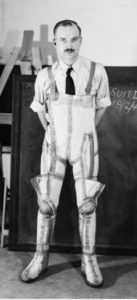
Figure: Wilber Frank’s Anti-Gravity Suit
Dr. Wilbur Franks has been credited with saving the lives of thousands of fighter pilots. His G-suit, developed in 1942, has been worn by every air force pilot in the world, as well as the astronauts and cosmonauts.
After the death of his mentor Frederick Banting in 1941, Wilber Franks continued Banting’s research into aviation medicine and the problem of Allied fighter pilots losing consciousness during high-speed exercises. The pilots were subject to immense gravitational forces, making it difficult for the heart to pump blood to the brain.
Franks initially came up with the idea of a water-filled G-suit. By filling an outer layer with water that pressed on the legs and abdomen to prevent blood from pooling in the lower parts of the body, Franks could keep the pilots’ blood circulating normally Later designs used air pressure instead of water pressure and included an inflatable bladder. The Franks Flying Suit was first used in combat by the Royal Navy Fleet Air Arm in an invasion of North Africa in November 1942.


can you tell me more ples
Our apology for not responding sooner however your comment was overlooked. That said, what exactly would you like to know that a Google search won’t provide.